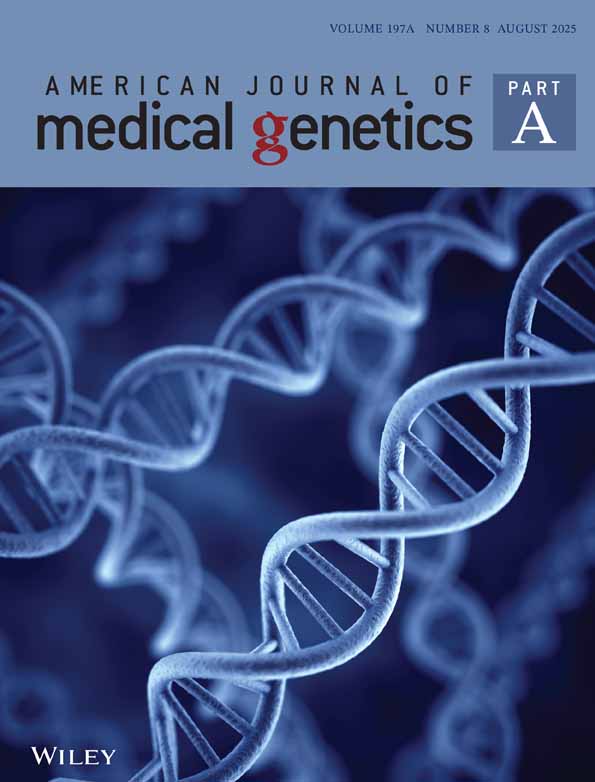Epidemiology and genetics of craniosynostosis
To the Editor
The article “Craniosynostosis in Western Australia, 1980–1994: A population-based study” [Singer et al., 1999] provides a useful contribution to the literature on the epidemiology of craniosynostosis. However, it contains some statements that could mislead readers unaware of the recent literature. My purpose here is briefly to discuss the broader context of two aspects of this study: the diagnosis of lambdoid synostosis, and the molecular genetic investigation of apparently non-syndromic craniosynostosis.
Singer et al. [1999] obtained an overall prevalence of craniosynostosis of 1 in 1976, including 21.8% of cases diagnosed as having lambdoid synostosis. Moreover, they identified an apparent linear increase in lambdoid synostosis of 15.7% per year during their study period, and an association of this diagnosis with instrumental vaginal delivery. Concerns about the very high apparent frequency of lambdoid synostosis in this study may be raised on four counts. First, distinction of this diagnosis from non-synostotic (deformational) posterior plagiocephaly is not trivial; second, deformational plagiocephaly is associated with complicated delivery; third, there has been a well-documented increase in deformational posterior plagiocephaly over the past decade, probably as a result of sleeping babies on their backs [Mulliken et al., 1999]; and fourth, there has been a historical tendency to overdiagnose lambdoid synostosis [Cohen, 1996].
Accurate differentiation of lambdoid synostosis from deformational posterior plagiocephaly requires thorough radiological work-up (including skull radiographs and computed tomography with 3D reconstruction), clinical experience, and corroboration at surgery. Table I summarizes six recent surgical series, from established craniofacial units, that have placed particular emphasis on making this diagnostic distinction [Chadduck et al., 1997; Huang et al., 1996; Menard and David, 1998; Mulliken et al., 1999; Pollack et al., 1997; Pople et al., 1996]. The data indicate that true lambdoid synostosis is unusual both as a cause of posterior plagiocephaly (2.9% of cases from six series, n = 713), and in relation to craniosynostosis as a whole (3.3% of cases from two series, n = 453). Correct distinction between true lambdoid synostosis and deformational posterior plagiocephaly is imperative because the latter generally responds to conservative management: in the six series quoted in Table I, the overall operation rate for deformational plagiocephaly was 4.8% (n = 692) and in two of the series, surgery for this condition was avoided altogether.
|
Huang et al. [1996] |
Pople et al. [1996] |
Chadduck et al. [1997] |
Pollack et al. [1997] |
Menard and David [1998] |
Mulliken et al. [1999] |
Total | |
|---|---|---|---|---|---|---|---|
| Cases of posterior plagiocephaly | 102 | 100 | 121 | 71 | 204 | 115 | 713 |
| True lambdoid synostosis | 4 | 9 | 3 | 2 | 2 | 1 | 21 |
| Deformational plagiocephaly: | |||||||
| Conservative management | 95 | 82 | 116 | 69 | 183 | 114 | 659 |
| Operative intervention | 3 | 9 | 2 | 0 | 19 | 0 | 33 |
| Cases of craniosynostosis | 130 | naa | na | na | na | 323 | 453 |
| True lambdoid synostosis | 4 | 11 | 15 |
- a na, not available.
Given this background, the criteria used by Singer et al. [1999] to make a diagnosis of lambdoid synostosis appear insufficiently rigorous, especially considering that a dedicated craniomaxillofacial unit was not established until the last year of their study. Although it is stated by Singer et al. [1999] that the overall prevalence of craniosynostosis is amongst the lowest reported, removal even of all 37 cases of lambdoid synostosis from their data would give a prevalence of craniosynostosis of 1 in 2,526—similar to the estimate of Hunter and Rudd [1976] and only slightly lower than the figure of 1 in 2,100 of Lajeunie et al. [1995]. It should be noted that some of the other epidemiological studies quoted by Singer et al. [1999] are also likely to be flawed by overestimates of the prevalence of lambdoid synostosis.
I am also concerned that the study of Singer et al. [1999] makes no reference to recent molecular genetic findings in craniosynostosis. They note that “paternal age risk persisted after cases of known autosomal dominant syndromes were excluded,” and that this “raises the possibility that new mutations may be accounting for at least some of the so-called nonsyndromic cases.” Yes, indeed! The description of the Pro250Arg mutation in fibroblast growth factor receptor 3 (FGFR3) identified a craniosynostosis syndrome (Muenke syndrome; MIM 602849) defined by genotype rather than phenotype [Bellus et al., 1996; Muenke et al., 1997]. The Pro250Arg mutation in FGFR3 is very common. In three series of non-syndromic coronal synostosis, the prevalence of this mutation was 31% in unselected cases [Moloney et al., 1997], 74% and 17%, respectively, in familial and non-familial cases [Lajeunie et al., 1999], and 11% in unilateral cases [Gripp et al., 1998]. Although a paternal age effect has not yet been formally demonstrated for this mutation, increased paternal age has been observed for the equivalent Pro253Arg Apert syndrome mutation in FGFR2 [Moloney et al., 1996] and for the Gly380Arg achondroplasia mutation in FGFR3 [Wilkin et al., 1998]. The Muenke syndrome mutation is therefore likely to account, in part, for the observed paternal age effect. Mutations of other genes may also be associated with non-syndromic craniosynostosis: the Ala344Ala splicing mutation in FGFR2 is one example [Steinberger et al., 1996].
Although I would entirely agree with Singer et al. [1999] on the need to ensure that families with craniosynostosis are offered genetic counseling, I would caution against attempting such counseling without the routine use of molecular genetic investigation.




